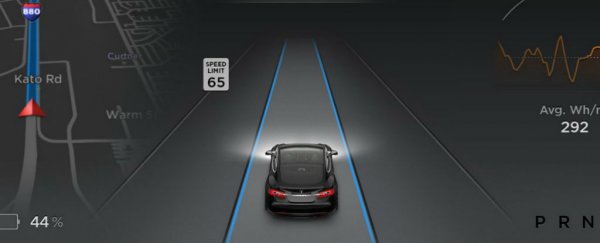When the history of the self-driving car is written, 5 October 2015 may well make it in as a footnote: it's the day when Tesla began rolling out an Autopilot software update to its fleet of Model S cars. The long-anticipated update activates the self-driving hardware that's been built into the vehicles' manufacturing and production processes since late last year.
To be clear, these cars aren't suddenly going to develop a mind of their own and start taking control - fully autonomous vehicles aren't yet road legal, for a start - but the update does allow Tesla drivers to go 'hands-free' on the highway. A manual override will still be possible at all times, but Model S automobiles can now automatically adjust their speed and stay in the correct lane without any effort or intervention from the driver.
The Autopilot software upgrade was announced last year and you can think of it as being like a very advanced type of cruise control. It's only really suitable for the freeway at the moment, but it's an important step forward for autonomous automobile technology. The primary feature is called Autosteer, which uses the road markings to keep in the centre of the current lane, and radar sensors to judge the distance between you and the car in front (and alter your speed if necessary).
The software also includes Auto Lane Change, where a tap on the indicator is enough to change lanes (the car takes care of waiting for a big enough gap), and Autopark, which can swing your vehicle into a tight parking space all by itself.
Even with all of this technology now available, Tesla insists that drivers must keep their hands on the wheel at all times. A fully autonomous driving experience is on the way, but we're not there yet - and Tesla doesn't want to be held responsible for accidents until its software is a lot more mature. The data from Autopilot-enabled cars will be fed back to the company and used to improve the software for future releases.
"Today's update increases the driver's confidence behind the wheel with features to help the car avoid hazards and reduce the driver's workload," says Tesla. "While Model S can't make traffic disappear, it can make it a lot easier, safer, and more pleasant to endure."
The kit that enables this functionality includes a forward radar, a forward-facing camera, 360-degree ultrasonic sensors and GPS (Tesla says a hardware upgrade will eventually be required to make its cars fully self-driving). These motors can also tap into the company's high-resolution navigation maps, which are augmented by information gathered by the vehicles as they travel. Next in line for the update should be the Model X, which has the same hardware setup as the Model S.
